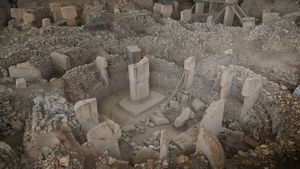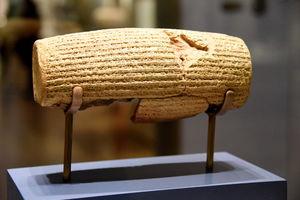Difference between revisions of "Archive:Tlha Ngai"
m (fixed sum stuuf) |
m (added Death Pillars) |
||
| Line 180: | Line 180: | ||
===Heritage=== | ===Heritage=== | ||
====Death Pillars==== | |||
[[File:Deathpillar.jpg|thumbnail|right|Circle graveyard which is next to the Central Circle .]] | |||
Death Pillars, otherwise also known as Graveyard Pillars or Circle Graveyards, is a historical site near [[Nga Kxe]] . The site was found in 1971 by local archaeologist XXX, who dated the ruins to be at least 900 years old, but other archaeologist from all over the world have estimate the age of the ruins to be from 1300 years to 500 years old. This site has been the largest excavated area in Shyorian history, in which circular graveyards have been found, ranging from 5 meters to 15 meters in diameter. The whole excavated site was a circular area with a diameter of about 100 meters. | |||
The biggest circular graveyard, the Central Circle has a diameter of 30 meters, where plenty of pillars, heights ranging from half a meter to 3 meters, stand in circles. The use of the pillars are unknown but are believed to have held caskets and urns. What makes this graveyard the most interesting is the lack of bodies in the circle, 0 bones in fact. It is still a mystery to this day why there are no bones of any kind in the oldest and biggest of the graveyards in the Death Pillars. Many have blamed extraterrestrial life, grave diggers, shamans, and zombies. But the graves have been not touched after the bodies were buried, which makes the disappearing bodies even more mysterious. | |||
[[File:Partofpillar.jpg|thumbnail|right|Part of a pillar with carved old alphabet .]] | |||
The writings on the pillars are written in Old Shyorian, but not in the writing system which is used nowadays. They are written in the old alphabetic form, which was derived originally from the Cananabas and a little later the Osveraalis. These markings are also the only found source of the old alphabetic form and only a few letters have been deciphered. | |||
===Architecture=== | ===Architecture=== | ||
Revision as of 15:38, 11 May 2019
| Divine Tlha Ngai Dynasty WӑбЪ ẂцнвцнаП YдТ ZиӯрисӭҳпӐ |
||||||
|---|---|---|---|---|---|---|
|
||||||
| Capital and | Nga Kxe | |||||
| Official languages | Shyorian | |||||
| Recognised national languages | Osveraali | |||||
| Ethnic groups | Dalar | |||||
| Demonym | Shyorian | |||||
| Government | Dynastic Monarchy | |||||
| Population | ||||||
| - | 2017 estimate | 8,984,351 | ||||
| Date format | yyyy.dd.mm CE | |||||
| Drives on the | right | |||||
Tlha Ngai (Shyorian: Ⱡôqa Ńâî /t͡ɬɜʡa ɳɒɪ/), officially the Divine Tlha Ngai Dynasty, is a country located on Atsiq, bordered by Dachashk in the north. The language and the culture survived under the Osveraali Empire because the state of Tlha Ngai was a great ally to the Dachashkis when they gathered power in the early years of the empire. Over the age of the empire, the Tlha Ngai state was given the most autonomy out of the other autonomous areas in the empire.
Etymology
History
Pre-writing
The first signs of civilization on Atsiq are marked at Nga Kxe and date around 500CE. Though many Atsiqans belive that civilization on Atsiq started earlier. The natives were primarily hunters and gatherers, also dabbling a little in agriculture, and though their techniques were, compared to other civilizations at the time, poor, their canals were first class and plenty of them have survived and can be seen today.
Tlha Ngai Dynasty
After loaning writing from the Cananas around 1000CE, the Tlha Ngai family grew to power in Nga Kxe and extended their influence outside the valley to nowadays Thaneqh. Growing in power, they established the first, and so far the only dynasty and led the formed country of Tlha Ngai, which they named after themselves, but the country is also known as Shyoria or Shyorisaech due to the original region being called that. All of the vassals of Tlha Ngai gained wealth under the dynasty due to trade and plenty of them were assimilated and incorporated into Tlha Ngai.
Osveraali Empire
Geography
Geology
Climate
Biodiversity
Politics
Government
Administrative divisions
Foreign relations
Military
Economy
Transport
Energy
Science and technology
Tourism
Demographics
Ethnic groups
Urbanisation
Language
Education
Healthcare
Religion
Culture
Heritage
Death Pillars
Death Pillars, otherwise also known as Graveyard Pillars or Circle Graveyards, is a historical site near Nga Kxe . The site was found in 1971 by local archaeologist XXX, who dated the ruins to be at least 900 years old, but other archaeologist from all over the world have estimate the age of the ruins to be from 1300 years to 500 years old. This site has been the largest excavated area in Shyorian history, in which circular graveyards have been found, ranging from 5 meters to 15 meters in diameter. The whole excavated site was a circular area with a diameter of about 100 meters.
The biggest circular graveyard, the Central Circle has a diameter of 30 meters, where plenty of pillars, heights ranging from half a meter to 3 meters, stand in circles. The use of the pillars are unknown but are believed to have held caskets and urns. What makes this graveyard the most interesting is the lack of bodies in the circle, 0 bones in fact. It is still a mystery to this day why there are no bones of any kind in the oldest and biggest of the graveyards in the Death Pillars. Many have blamed extraterrestrial life, grave diggers, shamans, and zombies. But the graves have been not touched after the bodies were buried, which makes the disappearing bodies even more mysterious.
The writings on the pillars are written in Old Shyorian, but not in the writing system which is used nowadays. They are written in the old alphabetic form, which was derived originally from the Cananabas and a little later the Osveraalis. These markings are also the only found source of the old alphabetic form and only a few letters have been deciphered.



